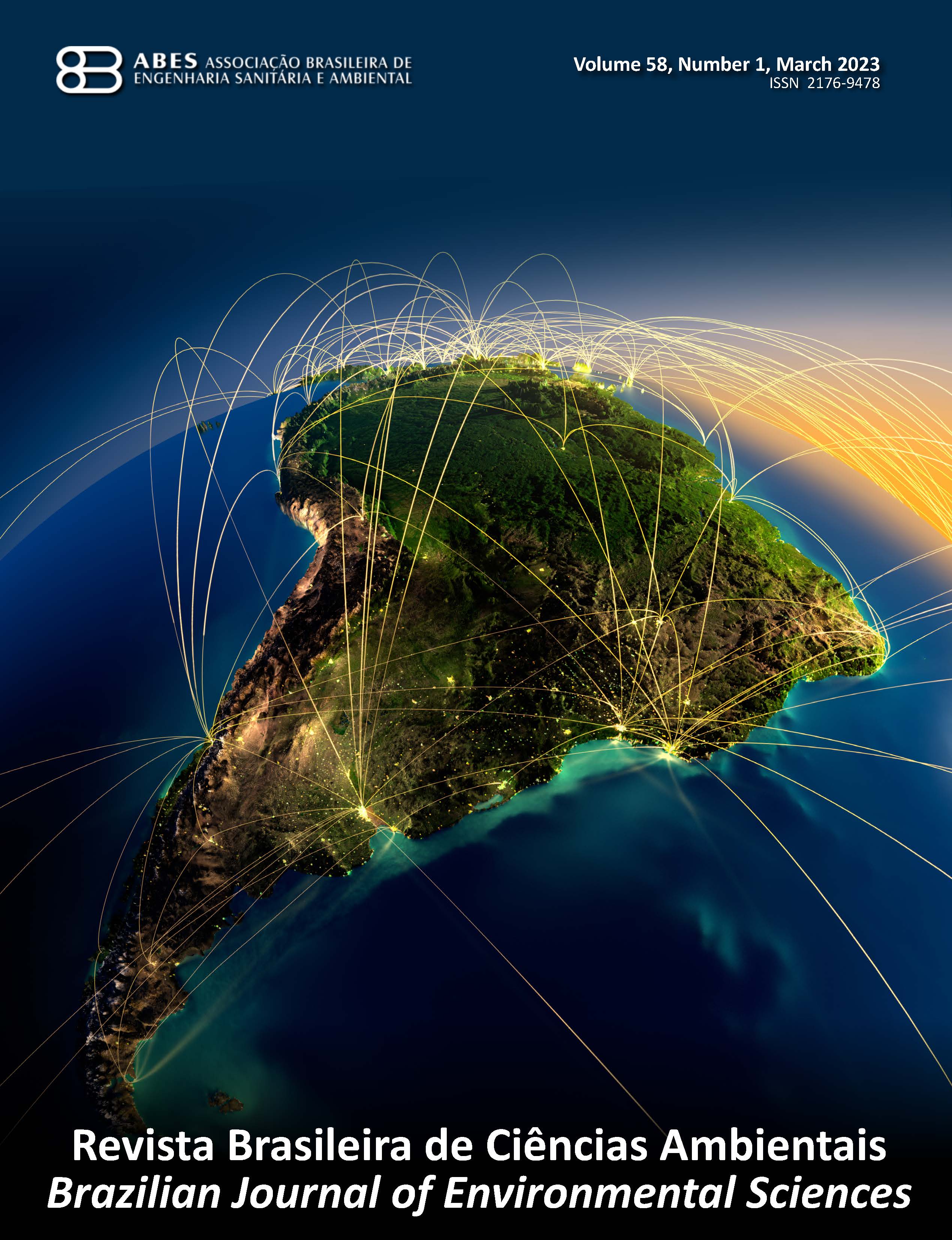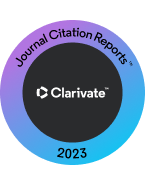Effect of granulometric characteristics of the filtration medium in prefiltration systems for domestic use purposes in isolated rural communities
DOI:
https://doi.org/10.5327/Z2176-94782180Keywords:
safe water; decentralized water treatment; pre-treatment; filtering material; grain size distribution.Abstract
Decentralized water treatment systems have limitations when raw water has high concentrations of impurities. This study evaluated the influence of different granulometric characteristics of the filter medium on the clogging in pre-filtration systems for domestic use in isolated rural communities, to minimize the impact of impurities in fresh raw water on final treatment. Three pre-filters, filled with filtration material with effective diameters of 0.20, 0.40, and 0.60 mm, and low uniformity coefficient (1.6), were operated continuously for 116 days. At a depth of 5–20 cm, 87, 57, and 41% of the total head loss were concentrated in the granulometries of 0.20, 0.40, and 0.60 mm effective diameters, respectively. Except for apparent color, no statistical difference was identified in water quality parameters between the different granulometries used in the study. The pre-filters showed an average turbidity removal efficiency of 65%. True and apparent colors presented an average removal of 32 and 39%, respectively. Total coliforms were found up to 15 cm deep in the filtration medium. Heterotrophic bacteria were observed throughout the depth of the filtration medium, with more than 1,000 bacterial colonies found. The use of filter media with a larger effective diameter can bring operational benefits, as it shows cleaning frequencies two to three times lower than filter media with smaller granulometry, besides presenting longer filtration runs, minimizing the impact of system operation errors by the owner.
Downloads
References
Abdiyev, K.; Azat, S.; Kuldeyev, E.; Ybyraiymkul, D.; Kabdrakhmanova, S.; Berndtsson, R.; Sultakhan, S., 2023. Review of slow sand filtration for raw water treatment with potential application in less-developed countries. Water, v. 15 (11), 2007. https://doi.org/10.3390/w15112007.
Agbo, K.E.; Ayité, Y.M.X.D.; Pachoukova, I., 2021. Study of head loss in rapid filtration with four river sands. Civil Engineering Journal, v. 7 (4), 690-700. https://doi.org/10.28991/cej-2021-03091682.
American Public Health Association (APHA), 2017. Standard methods for the examination of water and wastewater. APHA, American Water Works Association, Water Environment Federation, Washington.
Amirtharajah, A., 1988. Some theoretical and conceptual views of filtration. Journal‐American Water Works Association, v. 80 (12), 36-46. https://doi.org/10.1002/j.1551-8833.1988.tb03147.x.
Andreoli, F.C.; Sabogal-Paz, L.P., 2020. Household slow sand filter to treat groundwater with microbiological risks in rural communities. Water Research, v. 186, 116352. https://doi.org/10.1016/j.watres.2020.116352.
Baveye, P.; Vandevivere, P.; Hoyle, B.L.; DeLeo, P.C.; de Lozada, D.S., 1998. Environmental impact and mechanisms of the biological clogging of saturated soils and aquifer materials. Critical Reviews in Environmental Science and Technology, v. 28 (2), 123-191. https://doi.org/10.1080/ 10643389891254197.
Bennacer, L.; Ahfir, N.D.; Alem, A.; Huaqing, W., 2022. Influence of particles sizes and flow velocity on the transport of polydisperse fine particles in saturated porous media: Laboratory experiments. Water, Air, & Soil Pollution, v. 233 (7), 249. https://doi.org/10.1007/s11270-022-05732-4.
Brasil, 2021. Portaria GM/MS nº 888, de 04 de maio de 2021. Ministério da Saúde, Brasília, p. 29.
Carrier III, W.D., 2003. Goodbye, hazen; hello, kozeny-carman. Journal of Geotechnical and Geoenvironmental Engineering, v. 129 (11), 1054-1056. https://doi.org/10.1061/(ASCE)1090-0241(2003)129:11(1054).
Cescon, A.; Jiang, J.Q., 2020. Filtration process and alternative filter media material in water treatment. Water, v. 12 (12), 3377. https://doi.org/10.3390/w12123377.
Chan, T.; MacDonald, M.C.; Kearton, A.; Elliott, M.; Shields, K.F.; Powell, B.; Hadwen, W. L., 2020. Climate adaptation for rural water and sanitation systems in the Solomon Islands: A community scale systems model for decision support. Science of the Total Environment, v. 714, 136681. https://doi.org/10.1016/j.scitotenv.2020.136681.
Chen, L.; Zhai, Y.; van der Mark, E.; Liu, G.; van der Meer, W.; Medema, G., 2021. Microbial community assembly and metabolic function in top layers of slow sand filters for drinking water production. Journal of Cleaner Production, v. 294, 126342. https://doi.org/10.1016/j.jclepro.2021.126342.
De Souza, F.H.; Pizzolatti, B.S.; Sens, M.L., 2021a. Backwash as a simple operational alternative for small-scale slow sand filters: from conception to the current state of the art. Journal of Water Process Engineering, v. 40, 101864. https://doi.org/10.1016/j.jwpe.2020.101864.
De Souza, F.H.; Roecker, P.B.; Silveira, D.D.; Sens, M.L.; Campos, L.C., 2021b. Influence of slow sand filter cleaning process type on filter media biomass: backwashing versus scraping. Water Research, v. 189, 116581. https://doi.org/10.1016/j.watres.2020.116581.
Dubuis, R.; De Cesare, G., 2023. The clogging of riverbeds: A review of the physical processes. Earth-Science Reviews, v. 239, 104374. https://doi.org/10.1016/j.earscirev.2023.104374.
Freitas, B.L.S.; Sabogal-Paz, L.P., 2019. Pretreatment using Opuntia cochenillifera followed by household slow sand filters: technological alternatives for supplying isolated communities. Environmental Technology. https://doi.org/10.1080/09593330.2019.1582700.
Freitas, B.L.S.; Terin, U.C.; Fava, N.D.M.N.; Sabogal-Paz, L.P., 2021. Filter media depth and its effect on the efficiency of household slow sand filter in continuous flow. Journal of Environmental Management, v. 288, 112412. https://doi.org/10.1016/j.jenvman.2021.112412.
Freitas, B.L.S.; Terin, U.C.; Sabogal-Paz, L.P., 2023. Household slow sand filters in intermittent and continuous flow for a long-term surface water treatment: efficiencies assessment and operational challenges. Journal of Environmental Chemical Engineering, v. 11 (3), 110090. https://doi.org/10.1016/j.jece.2023.110090.
Fundação Nacional de Saúde (FUNASA), 2019. Caderno Técnico: projeto e operação de filtros lentos retrolaváveis para o tratamento de água para abastecimento. Copiart, Florianópolis, p. 64.
Hägg, K.; Pott, B.M., 2022. Filter media for basin infiltration: a case study. Water Practice & Technology, v. 17 (7), 1505-1514. https://doi.org/10.2166/wpt.2022.074.
Herzig, J.P.; Leclerc, D.M.; Goff, P.L., 1970. Flow of suspensions through porous media—application to deep filtration. Industrial & Engineering Chemistry, v. 62 (5), 8-35. https://doi.org/10.1021/ie50725a003.
Lin, S.; Wang, X.; Chao, Y.; He, Y.; Liu, M., 2016. Predicting biofilm thickness and biofilm viability based on the concentration of carbon-nitrogen-phosphorus by support vector regression. Environmental Science and Pollution Research, v. 23, 418-425. https://doi.org/10.1007/s11356-015-5276-y.
Liu, H.L.; Li, X.; Li, N., 2023. Application of bio-slow sand filters for drinking water production: Linking purification performance to bacterial community and metabolic functions. Journal of Water Process Engineering, v. 53, 103622. https://doi.org/10.1016/j.jwpe.2023.103622.
Lunardi, S.; Martins, M.; Pizzolatti, B.S.; Soares, M.B.D., 2022. Pre‐filtration followed by slow double‐layered filtration: Media clogging effects on hydraulic aspects and water quality. Water Environment Research, v. 94 (4), e10709. https://doi.org/10.1002/wer.10709.
Manger, G.E., 1963. Porosity and bulk density of sedimentary rocks (No. 1144-E). USGPO, Washington, D.C.
Martins, M.; Lunardi, S.; Puhl, V.D.A.; Pizzolatti, B.S.; Soares, M., 2021. Enzymatic analysis in bank filtration sites as a tool for assessing biological clogging—A column study. Journal of Water Process Engineering, v. 44, 102375. https://doi.org/10.1016/j.jwpe.2021.102375.
Mohamed, A.Y.A.; Tuohy, P.; Healy, M.G.; Ó hUallacháin, D.; Fenton, O.; Siggins, A., 2023. Effects of wastewater pre-treatment on clogging of an intermittent sand filter. Science of the Total Environment, v. 876, 162605. https://doi.org/10.1016/j.scitotenv.2023.162605.
Normenausschuss, D., 1983. DIN 18123. Bestimmung der Korngrößenverteilung, Berlin.
Organização das Nações Unidas (ONU), 2015. Agenda 2030 | ONU Brasil. ONU, Nova Iorque.
Pizzolatti, B.; Soares, M.; Romero, L.; Sens, M., 2014. Comparison of backwashing with conventional cleaning methods in slow sand filters for small-scale communities. Desalination and Water Treatment, v. 54 (1072954), 1-7. https://doi.org/10.1080/19443994.2013.879080.
Princ, T.; Fideles, H.M.R.; Koestel, J.; Snehota, M., 2020. The impact of capillary trapping of air on satiated hydraulic conductivity of sands interpreted by X-ray microtomography. Water, v. 12 (2), 445. https://doi.org/10.3390/w12020445.
Puhl, V.A.; Martins, M.; Lunardi, S.; Pizzolatti, B.S.; Toebe, M.; Decezaro, S.T.; Medeiros, R.C. Soares, M., 2023. Enzymatic analysis in household intermittent slow sand filters as a tool for assessing biological clogging. Journal of Water Process Engineering, v. 55, 104177. https://doi.org/10.1016/j.jwpe.2023.104177.
Soares, M., 2015. The influence of high infiltration rates, suspended sediment concentration and sediment grain size on river and lake bed clogging. Doctoral Thesis. Institute of Environmental Technology. Technische Universitaet Berlin (Germany). https://doi.org/10.14279/depositonce-4399.
Song, S.; Rong, L.; Dong, K.; Liu, X.; Le Clech, P.; Shen, Y., 2020. Particle-scale modelling of fluid velocity distribution near the particles surface in sand filtration. Water Research, v. 177, 115758. https://doi.org/10.1016/j.watres.2020.115758
Souza, V.A.A.; Pizella, D.G., 2021. The Brazilian surface freshwater framework in union-dominated rivers: challenges and prospects for water quality management. Revista Brasileira de Ciências Ambientais (RBCIAMB), v. 56 (1), 1-15. https://doi.org/10.5327/Z2176-947820200707.
Tang, Y.; Yao, X.; Chen, Y.; Zhou, Y.; Zhu, D.Z.; Zhang, Y.; Peng, Y., 2020. Experiment research on physical clogging mechanism in the porous media and its impact on permeability. Granular Matter, v. 22, 1-14. https://doi.org/10.1007/s10035-020-1001-8.
Trussell, R.R.; Chang, M., 1999. Review of flow through porous media as applied to head loss in water filters. Journal of Environmental Engineering, v. 125 (11), 998-1006. https://doi.org/10.1061/(ASCE)0733-9372(1999)125:11(998).
Waldschläger, K.; Schüttrumpf, H., 2020. Infiltration behavior of microplastic particles with different densities, sizes, and shapes—from glass spheres to natural sediments. Environmental Science & Technology, v. 54 (15), 9366-9373. https://doi.org/10.1021/acs.est.0c01722.
Wang, F.; Yao, Y.; Wen, Z.; Sun, Q.; Yuan, X., 2020. Effect of water occurrences on methane adsorption capacity of coal: A comparison between bituminous coal and anthracite coal. Fuel, v. 266 (117102), 1-12. https://doi.org/10.1016/j.fuel.2020. 117102.
World Health Organization (WHO), 2024. Guidelines for drinking-water quality: small water supplies. WHO, Geneva.
Downloads
Published
How to Cite
Issue
Section
License
Copyright (c) 2025 Revista Brasileira de Ciências Ambientais

This work is licensed under a Creative Commons Attribution 4.0 International License.

























